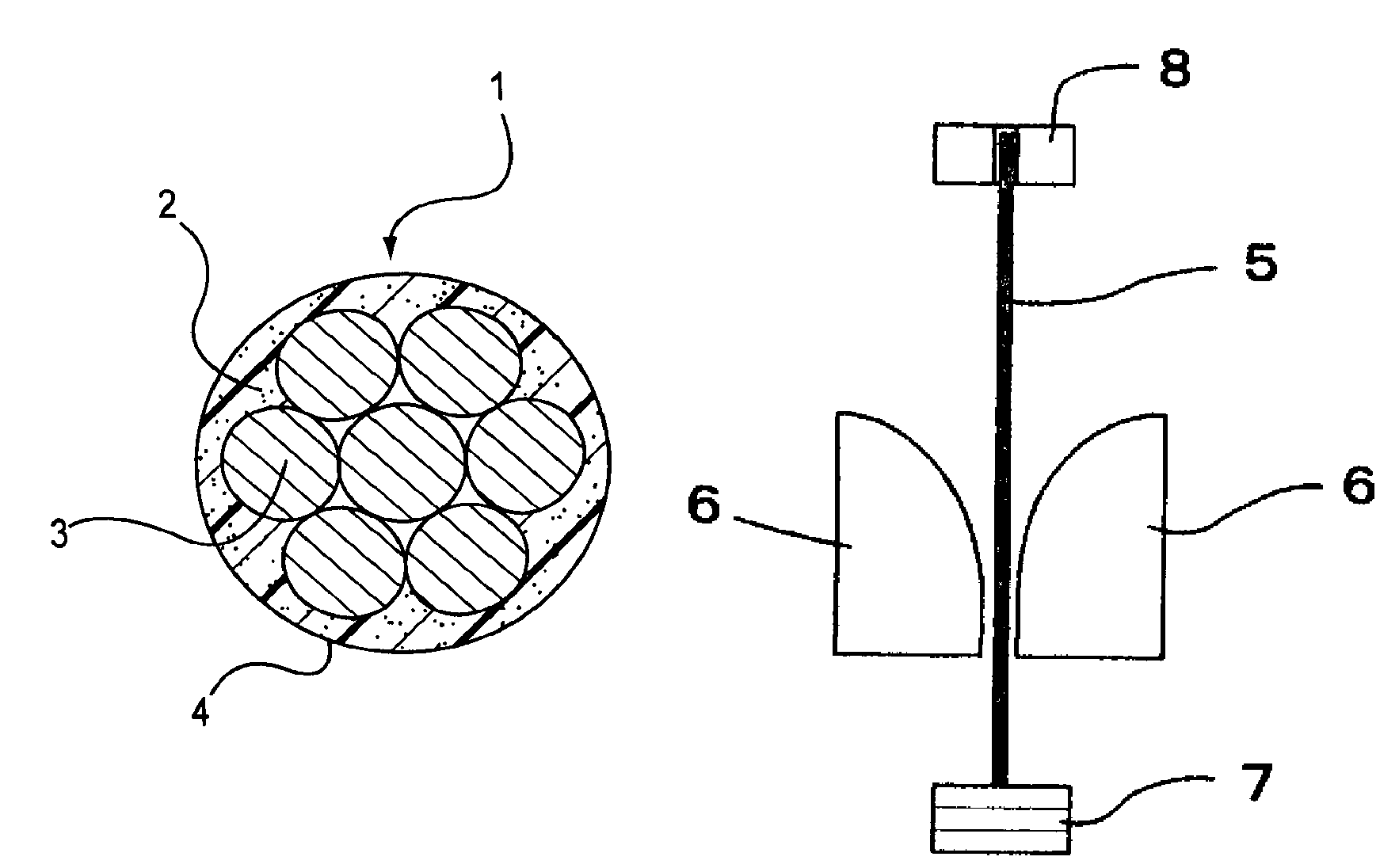Aluminum conducting wire
a technology of conducting wire and aluminum wire, which is applied in the direction of insulated conductors, cables, conductors, etc., can solve the problems of aluminum wire not being used in conventional structural parts, heavy weight, and serious reusing problems, and achieve excellent workability at wire drawing, reducing weight, and facilitating reusing of wires.
- Summary
- Abstract
- Description
- Claims
- Application Information
AI Technical Summary
Benefits of technology
Problems solved by technology
Method used
Image
Examples
example 1
[0046]Table 1 shows the component compositions (balance was an aluminum and inevitable impurities) of the Al alloys according to the Examples and Comparative examples. Al alloys each having the component composition shown in Table 1 each were melted by a usual method, and cast in a casting mold with a dimension of 25.4 mm square, to give ingots. Then, each of the ingots was kept at 400° C. for 1 hour, followed by hot rolling with a grooved roll to process into a rough drawing wire with a wire diameter of 9.5 mm. The method for processing into a rough drawing wire is not restricted to the hot rolling method using an ingot having a square cross section, and other processing methods such as a continuous cast-rolling method or an extrusion method may be used.
[0047]Subsequently, the obtained rough drawing wire was drawn into a wire with a wire diameter of 0.9 mm, followed by heat treatment at 350° C. for 2 hours and quenching, and the wire was further drawn, to obtain solid conductors of...
example 2
[0058]Stranded wire 2 with a cross sectional area of the conductor of 0.5 mm2 was prepared by stranding seven solid conductors of an aluminum alloy 3 (strand pitch 20 mm) with a wire diameter of 0.32 mm of the Examples 1 and 2 according to the present invention in Table 1 prepared in Example 1. One solid conductor was placed at the center and remaining 6 solid conductors were disposed around the center. The aluminum conducting wire as shown in FIG. 1-3 were prepared by coating the stranded solid conductors with a non-halogen resin 4 after a degressive work of the stranded solid conductors. The tensile strength of each conducting wire was measured to be 60 N or 75 N by the same method as in Example 1. These values are enough for satisfying reliability of the joint part between the aluminum conducting wire and the terminal in the assembly of automobiles.
example 3
[0059]Two stranded wires each having a cross sectional area of the conductor of 0.5 mm2 were prepared by stranding seven solid conductors of an aluminum alloy of Example 1 according to the present invention with a wire diameter of 0.32 mm or copper wires of the conventional example, as shown in FIG. 1-3 (strand pitch 20 mm). Each stranded wire was coated by a resin, and thirty stranded wires were bundles and wrapped with a PVC tape. The bundle of the stranded wires was used for evaluation of flexibility.
[0060]FIG. 3 is a view showing the flexibility test method. The sample 11 with a length of 350 mm was supported with reels 10 having a support diameter of 19 mm of a two-point support flexibility test jig 9 with a distance of support of 100 mm. Pull-out strength of the sample (conducting wire) 11 was measured by pulling the middle portion between both reels to the downward direction with a tensile tester (not shown) to evaluate flexibility. The reference numeral 12 denotes a PVC tape...
PUM
| Property | Measurement | Unit |
|---|---|---|
| tensile strength | aaaaa | aaaaa |
| diameter | aaaaa | aaaaa |
| mass % | aaaaa | aaaaa |
Abstract
Description
Claims
Application Information
 Login to View More
Login to View More - Generate Ideas
- Intellectual Property
- Life Sciences
- Materials
- Tech Scout
- Unparalleled Data Quality
- Higher Quality Content
- 60% Fewer Hallucinations
Browse by: Latest US Patents, China's latest patents, Technical Efficacy Thesaurus, Application Domain, Technology Topic, Popular Technical Reports.
© 2025 PatSnap. All rights reserved.Legal|Privacy policy|Modern Slavery Act Transparency Statement|Sitemap|About US| Contact US: help@patsnap.com



